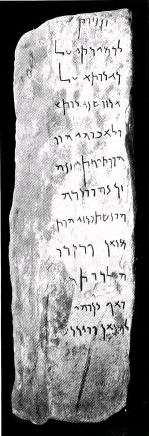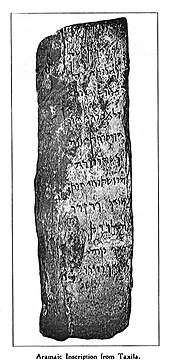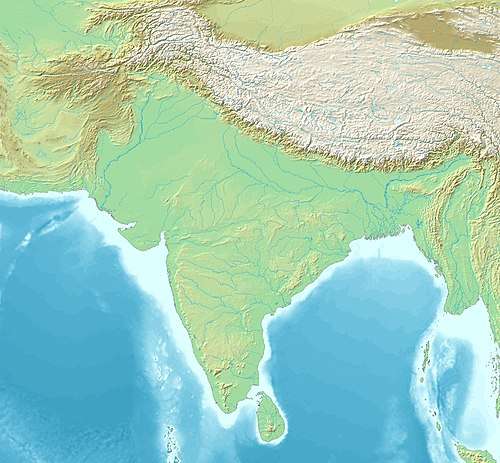Aramaic Inscription of Taxila
The Aramaic Inscription of Taxila 'is an inscription on a piece of marble, originally belonging to an octagonal column, discovered by Sir John Marshall in 1915 at Taxila, British India. The inscription is written in Aramaic, probably by the Indian emperor Ashoka around 260 BCE, and often categorized as one of the Minor Rock Edicts.[1] Since Aramaic was the official language of the Achaemenid empire, which disappeared in 330 BCE with the conquests of Alexander the Great, it seems that this inscription was addressed directly to the populations of this ancient empire still present in northwestern India, or to border populations for which Aramaic remained the normal communication language.[2] The inscription is known as KAI 273.
| Aramaic Inscription of Taxila | |
|---|---|
 Aramaic inscription of Taxila. | |
| Material | Portion of octagonal marble pillar. |
| Writing | Aramaic |
| Created | circa 260 BCE |
| Period/culture | 3rd Century BCE |
| Discovered | 33.7561N 72.8292E |
| Place | Sirkap, Taxila, Pakistan |
| Present location | Taxila Museum, Pakistan |

Related inscriptions
The discovery of this inscription was followed by that of several other inscriptions in Aramaic or Greek (or both), written by Asoka. The most famous are the Kandahar Bilingual Rock Inscription, written in Greek and Aramaic, or the Kandahar Greek Edict of Ashoka, also found in Kandahar. In 1932 another inscription in Aramaic was discovered in the Laghman Valley at Pul-i-Darunteh, then in 1963 an inscription in "Indo-Aramaic" alternating the Indian language and the Aramaic language, but using only the Aramaic script, the Aramaic parts translating the Indian parts transcribed in the Aramaic alphabet, also found in Kandahar. Finally, another inscription was found in Laghman, the Aramaic Inscription of Laghman.[2]
Text of the inscription
The text of the inscription is very fragmentary, but it has been established that it contains twice, lines 9 and 12, the mention of MR'N PRYDRŠ ("our lord Priyadasi"), the characteristic title used by Ashoka.:[1][3]
1 ... ... ... ... ut ... ...
2 l kmyrty l ...
3 kynvta l ...
4 ak zv shkynvta ...
5 v labvhy huh ...
6 hvptykhty znh ...
7 zk bhvvnrh ...
8 hvbshtv rzy hut ...
9 mram Prydr ...
10 am ....... lkvth ...
11 vap bnvhy ...
12 Imran Prydrsh ...
- Ruins of the city of Sirkap.
 Another image of the inscription.
Another image of the inscription.
See also
References
- Asoka by Radhakumud Mookerji p.275
- A new Aramaic inscription of Asoka found in the Laghman Valley (Afghanistan), André Dupont-Sommer Proceedings of the Academy of Inscriptions and Belles-Lettres Year 1970 114-1 p.173
- A new Aramaic inscription of Asoka discovered in Kandahar (Afghanistan), Dupont-Sommer, André, Records of the sessions of the Academy of Inscriptions and Belles-Lettres Year 1966 110-3 p.448
- Select Inscriptions Bearing On Indian History and Civilization Vol.1 of Sircar, Dines Chandra pp.78-79
| Edicts of Ashoka (Ruled 269–232 BCE) | |||||
| Regnal years of Ashoka |
Type of Edict (and location of the inscriptions) |
Geographical location | |||
| Year 8 | End of the Kalinga war and conversion to the "Dharma" |  Udegolam Nittur Brahmagiri Jatinga Rajula Mandagiri Yerragudi Sasaram Barabar Kandahar (Greek and Aramaic) Kandahar Khalsi Ai Khanoum (Greek city) | |||
| Year 10[1] | Minor Rock Edicts | Related events: Visit to the Bodhi tree in Bodh Gaya Construction of the Mahabodhi Temple and Diamond throne in Bodh Gaya Predication throughout India. Dissenssions in the Sangha Third Buddhist Council In Indian language: Sohgaura inscription Erection of the Pillars of Ashoka | |||
| Kandahar Bilingual Rock Inscription (in Greek and Aramaic, Kandahar) | |||||
| Minor Rock Edicts in Aramaic: Laghman Inscription, Taxila inscription | |||||
| Year 11 and later | Minor Rock Edicts (n°1, n°2 and n°3) (Panguraria, Maski, Palkigundu and Gavimath, Bahapur/Srinivaspuri, Bairat, Ahraura, Gujarra, Sasaram, Rajula Mandagiri, Yerragudi, Udegolam, Nittur, Brahmagiri, Siddapur, Jatinga-Rameshwara) | ||||
| Year 12 and later[1] | Barabar Caves inscriptions | Major Rock Edicts | |||
| Minor Pillar Edicts | Major Rock Edicts in Greek: Edicts n°12-13 (Kandahar) Major Rock Edicts in Indian language: Edicts No.1 ~ No.14 (in Kharoshthi script: Shahbazgarhi, Mansehra Edicts (in Brahmi script: Kalsi, Girnar, Sopara, Sannati, Yerragudi, Delhi Edicts) Major Rock Edicts 1-10, 14, Separate Edicts 1&2: (Dhauli, Jaugada) | ||||
| Schism Edict, Queen's Edict (Sarnath Sanchi Allahabad) Lumbini inscription, Nigali Sagar inscription | |||||
| Year 26, 27 and later[1] |
Major Pillar Edicts | ||||
| In Indian language: Major Pillar Edicts No.1 ~ No.7 (Allahabad pillar Delhi pillar Topra Kalan Rampurva Lauria Nandangarh Lauriya-Araraj Amaravati) Derived inscriptions in Aramaic, on rock: | |||||